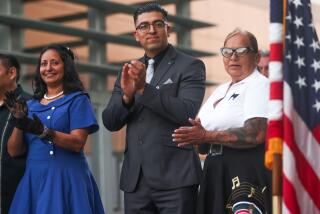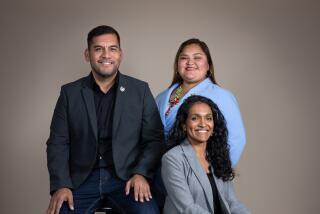It’s back to San Diego politics as usual in unusual mayoral election
SAN DIEGO — Councilman and mayoral candidate David Alvarez stood and applauded when acting Mayor Todd Gloria, in his state of the city address, proposed raising the minimum wage in San Diego beyond the scheduled statewide increases.
Councilman Kevin Faulconer, Alvarez’s opponent in the Feb. 11 election, remained seated, hands folded in his lap. He later told reporters that raising the minimum wage could be bad for business and lead to elimination of jobs.
Differences over economic issues illustrate the divide between Alvarez, a Democrat, and Faulconer, a Republican, as the hurry-up campaign to find a successor to the disgraced Bob Filner enters its final stretch with prickly debates and dueling TV commercials.
Alvarez supported a 2010 measure to boost the sales tax by half a cent, an increase that then-Mayor Jerry Sanders said was vital to prevent further cuts in city services because of the city’s spiraling pension payments.
Faulconer led the opposition, arguing that no taxes should be raised until the city finished reforming the pension system.
Voters agreed with Faulconer — Proposition B was defeated 62% to 38%. The appeal of smaller government is strong; nonpartisan polls suggest that Faulconer is leading Alvarez, particularly in more prosperous neighborhoods north of Interstate 8.
Alvarez supports raising a tax on developers to provide low-income housing. Faulconer opposes it — this time in alliance with Sanders — and calls it a “jobs tax.” The issue appears headed for the ballot.
Faulconer supports what could be called the San Diego orthodoxy: Hold down taxes, control spending, keep labor unions in check. That philosophy guided three successful mayors in recent decades: Republican Pete Wilson (who served from 1971 to 1983), Democrat Maureen O’Connor (1986-1992) and Sanders, a Republican (2005-2012).
Alvarez, a San Diego native, said he has seen that style of civic management result in certain neighborhoods being neglected by City Hall for lack of political clout, particularly in blue-collar areas. Among the disparities, he said, is a slower response time for firetrucks in some areas because of the location of stations.
“I’ve witnessed how people are treated differently depending on where they live in San Diego,” Alvarez said.
Asked about Wilson, O’Connor and Sanders, Alvarez said, “Those mayors neglected parts of this community. I have a different perspective.”
Without agreeing to Alvarez’s larger point about a past bias against some neighborhoods, Faulconer said it would not happen if he were mayor. Money for infrastructure needs such as filling potholes and fixing water lines would be spent where it’s needed most, Faulconer said.
Standing in a weed-filled empty lot in a neighborhood south of I-8, Faulconer promised tax incentives “to have development right here where we need it.”
Still, Faulconer stresses a concern that higher spending and taxation could prompt businesses to flee. “There’s a reason why Rick Perry comes to San Diego,” said Faulconer, a reference to the Texas governor’s forays here to persuade firms to relocate.
Despite their differences, Alvarez and Faulconer do not represent the same philosophical chasm that separated Filner and his Republican opponent in the 2012 election, Carl DeMaio. Aided by a large turnout for the presidential election, Filner swept into office, the first Democratic mayor in 20 years.
In Filner’s absence, mayoral politicking has reverted to form.
“This election marks a return to the traditional centrist pattern of San Diego politics: One candidate is center/right, the other center/left,” said Steve Erie, a political science professor at UC San Diego and coauthor of “Paradise Plundered: Fiscal Crisis and Governance Failures in San Diego.”
As councilman, Faulconer, 46, represents Mission Beach, Pacific Beach, Ocean Beach and Point Loma. Asked where his economic views were formed, he said at the dinner table from his father, a longtime deputy city manager in Oxnard.
Alvarez, 33, represents a district that includes Barrio Logan, Logan Heights, San Ysidro and Otay Mesa. His positions on economic issues, he said, also were shaped by his father, who was a janitor, and his mother, who worked at fast-food restaurants.
At debates, Alvarez and Faulconer poke at the source of each other’s financial support. Alvarez’s campaign and independent groups supporting him are largely funded by labor unions; in Faulconer’s case, funding tends to come from corporate and business groups.
Carl Luna, a political science professor at San Diego Mesa College, said much of the contest has descended to a “truly uninspiring level,” with an exchange of tired invectives: “You’re a corporate tool!” followed by the response of “You’re a union stooge!”
That “really does a disservice to San Diego voters,” Luna said. “I’m tempted to say the campaign has been lackluster, but that would be an understatement.”
More to Read
Sign up for Essential California
The most important California stories and recommendations in your inbox every morning.
You may occasionally receive promotional content from the Los Angeles Times.









